














Coordinating Editor Anabella McElroy coordinating@ubyssey.ca
News Editor Aisha Chaudhry news@ubyssey.ca
News Producer Renée Rochefort news@ubyssey.ca
Culture Editor Elena Massing culture@ubyssey.ca
Features Editor Iman Janmohamed features@ubyssey.ca
Opinion Editor Spencer Izen opinion@ubyssey.ca
Humour Editor Jocelyn Baker humour@ubyssey.ca
Science Editor Tova Gaster science@ubyssey.ca
Sports + Rec Editor Lauren Kasowski sports@ubyssey.ca
Visuals Editor Anya A Ameen visuals@ubyssey.ca
Photo Editor Isa S. You photo@ubyssey.ca
Video Editor Ravnoop Badesha video@ubyssey.ca
Business Manager Douglas Baird business@ubyssey.ca
Account Manager Forest Scarrwener advertising@ubyssey.ca
Web Developer Brittany Sampson b.sampson@ubyssey.ca
Web Developer Sam Low samuellow@ubyssey.ca
Web Developer Akshanjay Kompelli akshanjaykompelli@ubyssey.ca
Social Media Manager Jasmine Le social@ubyssey.ca
President Jalen Bachra president@ubyssey.ca
CONTACT
Editorial Office: NEST 2208 604.283.2023
Business Office: NEST 2209 604.283.2024
6133 University Blvd.
Vancouver, BC V6T 1Z1
Website: ubyssey.ca
Twitter: @ubyssey
Instagram: @ubyssey
Facebook: @ubyssey
TikTok: @ubyssey
We wish to acknowledge that we work, learn and operate the paper upon the occupied, traditional, ancestral and unceded territory of the Coast Salish peoples, including the xʷməθkʷəyəm (Musqueam), Sḵwxwú7mesh (Squamish), Stó:lō and səli lwətaɁɬ/Selilwitulh (Tsleil-Waututh).
The Ubyssey is the official student newspaper of the University of British Columbia (UBC).
It is published every second Tuesday by the Ubyssey Publications Society (UPS). We are an autonomous, democratically-run student organization and all students are encouraged to participate.
Editorials are written by The Ubyssey’s editorial board and they do not necessarily reflect the views of the UPS or UBC. All editorial content appearing in The Ubyssey is the property of the UPS. Stories, opinions, photographs and artwork contained herein cannot be reproduced without the expressed, written permission of the Ubyssey Publications Society.
The Ubyssey is a founding member of Canadian University Press (CUP) and adheres to CUP’s guiding principles.

The Ubyssey accepts opinion articles on any topic related to UBC and/or topics relevant to students attending UBC. Submissions must be written by UBC students, professors, alumni or those in a suitable position (as determined by the opinion editor) to speak on UBCrelated matters. Submissions must not contain
racism, sexism, homophobia, transphobia, harassment or discrimination. Authors and/ or submissions will not be precluded from publication based solely on association with particular ideologies or subject matter that some may find objectionable. Approval for publication is, however, dependent on the quality of the argument and The Ubyssey editorial board’s judgment of appropriate content. Submissions may be sent by email to opinion@ubyssey.ca
Please include your student number or other proof of identification. Anonymous submissions will be accepted on extremely rare occasions.
Requests for anonymity will be granted upon agreement from four-fifths of the editorial board.
Full opinions policy may be found at ubyssey.
ca/pages/submit-an-opinion

It is agreed by all persons placing display or classified advertising that if the UPS fails to publish an advertisement or if an error in the ad occurs the liability of the UPS will not be greater than the price paid for the ad. The UPS shall not be responsible for slight changes or typographical errors that do not lessen the value or the impact of the ads.
Aisha Chaudhry News EditorDr. Robert Crawford had no intention of going to university.
In fact, he never even thought about it.
That was until the summer of 1978, when new high school graduate Crawford spent his time working with his father at a Surrey gear factory.
To get the job, Crawford had to be set to attend university in the fall. So, he lied.
But that all changed once he met his co-workers — the three Brians.
“There were four of us [young men], all of whom had a father working in the factory,” said Crawford. “Believe it or not, I was the only one not named Brian.”
One Brian joked and swore, another was very pious and would get angry at the first for swearing and the last Brian “was so boring.”
“I can’t remember anything about him,” said Crawford.
But the joking and swearing Brian constantly talked about his degree and Arts One.
“My mother didn’t want me to go [to university], believe it or not,” said Crawford. “My father did.”
Crawford started thinking, but he didn’t consider university an option until halfway through that summer when his father talked to him during a factory workday.

“I never thought you’d wind up here like me,” Crawford recalled his father saying. “Get out of here.”
Unsure of his future and influenced by his father and Brian’s stories, “the wheels started turning.”
But it wasn’t stories about studying in a nook of Koerner Library or visiting professors for office hours in the old Arts One building that persuaded Crawford to go to university.
Brian “didn’t say anything about the academic culture … the readings.” He just talked about parties and drinking.
“There’s no way in the world I would have heard about Arts One if Brian hadn’t mentioned it,” said Crawford. “It was in the back of my mind ... for all the wrong reasons.”
But once Crawford started attending UBC, it didn’t take him long to realize partying wasn’t the only aspect of being a student.
“[University] was very difficult. It was academically very demanding, and I’m not sure I was prepared for that, to be honest with you,” said Crawford. “I didn’t have the best year of my life academically.”
Eventually, Crawford found his footing and graduated with a double major in political science and English literature.
But he didn’t stop there — Crawford received his PhD in political science and later became Arts One chair, a position he held until July.
The Arts One program began in 1967 “as an experiment,” according to Crawford.
“There was a lot of experimentation going on in the 60s in all kinds of areas, and one of those areas was pedagogy. Students were bored with the conventional standard timetables, and Arts One came along as … a pilot project for one year or two years [to] see what happens.”
“It’s been there ever since — kinda like me.”
Arts One welcomes around 100 students into its program every year, splitting them into seminar groups of 20 and tutorial groups of 4. In these tutorials, students read, analyze and give feedback on other students’ essays, emulating a small liberal arts college on UBC’s campus of over 60,000.
When Crawford was a student, he thought reading Thomas Hobbes’s Leviathan was “a punishment” — now, it’s his favourite text to teach.
“I hated [ Leviathan ]. I couldn’t stand it. I had no idea what I was reading.”
Despite his time as a student in the program, Crawford said it did little to prepare him for being on the other side of the lecture hall.
“Teaching was so different,” said Crawford. “I mean, I had fun as an undergrad … I spent a lot of time in the Pit. I spent a lot of time in the Gallery.”
Despite these changes, one thing stayed the same — being a “generalist” stuck with him from being a student to a professor.
The nature of Arts One, according to Crawford, forces professors to rarely discuss their areas of expertise. From philosophy, English and history to sociology, Latin American studies or political science — Arts One professors need to teach out of their wheelhouse.
But Crawford embraced it and continues being a generalist in his teaching style today. In fact, his favourite aspect of teaching is moving across “really strict disciplinary boundaries.”
“I’ve become a very generalist teacher, and I started as a very generalist student and I never got over it in a way,” said Crawford. “I always tell people that Arts One contaminated me with this
generalist orientation.”
MOVING BEYOND THE CANON
Tucked away from the hustle and bustle of campus, behind the Neville Scarfe building, sits a small green structure with large windows and surrounding shrubbery.
This — the then-Arts One building, now-film production building — is where Crawford found his home on campus.
The building was home to many parties and social gatherings, producing “a distinct kind of culture,” according to Crawford.
And this distinct culture has continued in the halls of Arts One — from the old building to the Gateway Space in IKB. When it comes to the program itself, Crawford said little has changed pedagogically, but change has occurred in what material is taught in the course.
Crawford said one of the “vulnerabilites” of Arts One and other liberal arts courses is that they tend to focus on texts created by “dead white guys.”
But, Crawford said, over time, that’s changed in Arts One.
“It isn’t just dead white guys,” said Crawford. “We read the Shakespeare still, we read the Hobbes still, we read the Plato still, and then we put it in conversation with other traditions ... I think those conversations are really important.”
Crawford started as an Arts One professor in the 90s after finishing his PhD — it was a “temporary structure,” something he would do for a couple of years, but “it just kind of evolved into something much bigger than that.” He has been with the program ever since, and will continue to teach in Arts One come September.
From student to professor and Arts One chair, Crawford has seen the program grow. And he’s grown alongside it.
“I’ve spent so much of my life in and around that program,” said Crawford. “For a long time … it was like, ‘Am I ever gonna get out of this place? … I feel, in a weird kind of way, very happy about it.” U

We think we’re the best student organization on campus, but don’t take our word for it — be a part of your student newspaper! Here are a few ways to get involved:
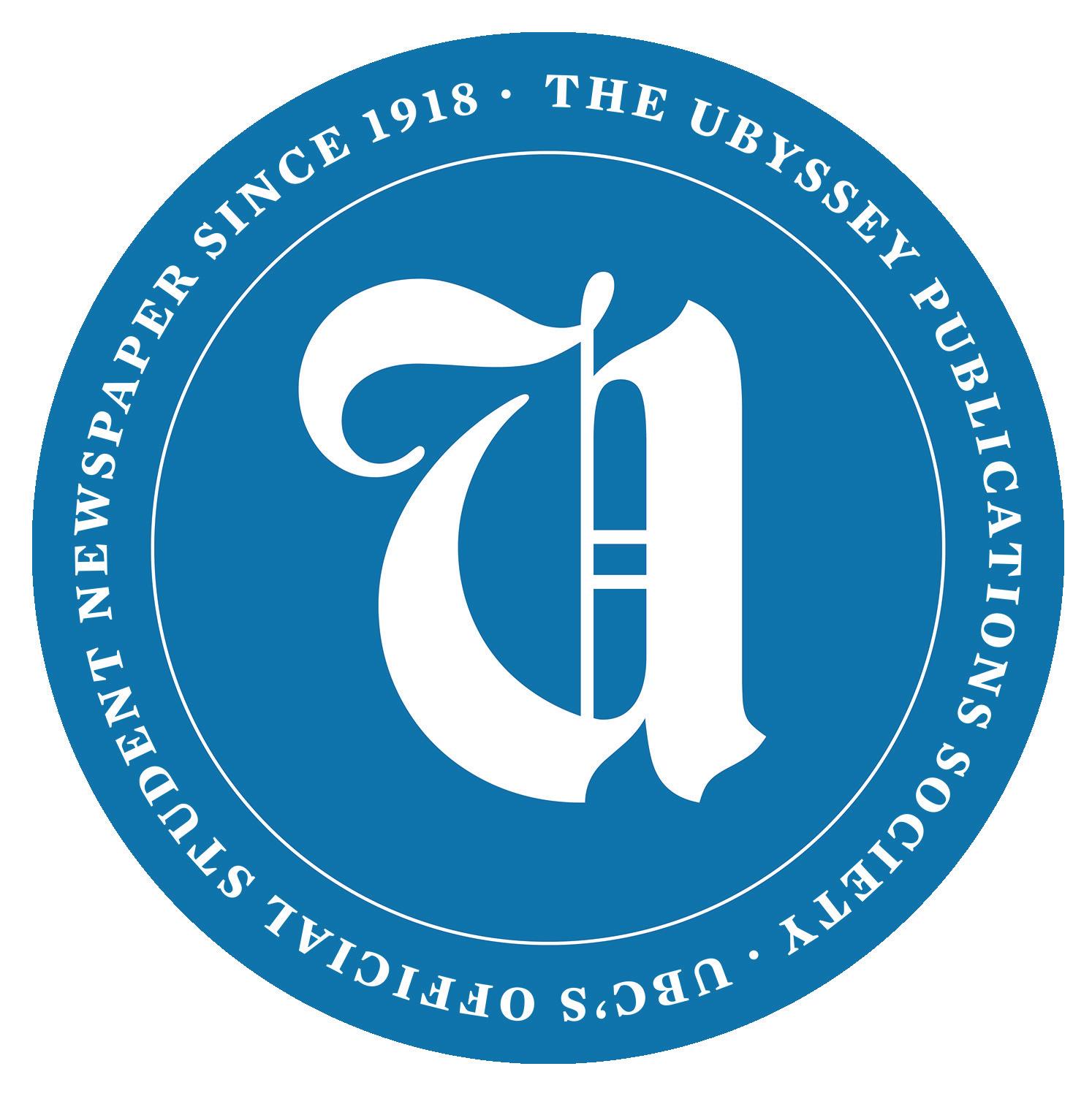
1. Join our Discord, where we send community updates, meeting times and more
2. Sign up for pitch lists to start writing articles, taking photos, making illustrations and more at ubyssey.ca/
3. Come to a staff meeting (Fridays at 4 p.m. in room 2208 in the Nest)



4. Help us copyedit our print issues every other Monday at 10 a.m. in our office, starting September 11


On August 1, UBC residences reduced access to commonsblock services.
In an email sent to residents, UBC Student Housing and Community Services (SHCS) said the front desk will only be staffed from 7 a.m. to 11 p.m. daily, while front desks had previously been 24/7.
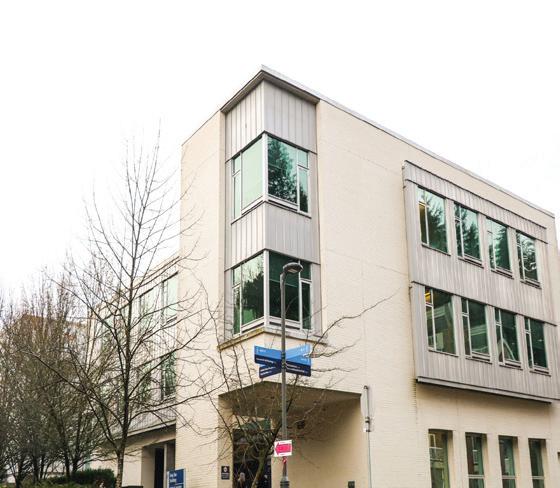

The front desk closure will restrict the use of commonsblock services including assistance from front desk staff, laundry rooms and study spaces to those hours.

SHCS cited staffing issues leading to “last-minute closures and temporary reductions of services to students” as the main driver behind this change.
SHCS is introducing a new overnight mobile team that will work between 11 p.m. and 7 a.m. to support students in residence when the front desk is closed.
The mobile team will work alongside campus security and connect students to emergency services.
However, many students were disappointed by the changes due to lack of consultation.
Shawn Fu, a third-year civil engineering student, said the change “is not something that works for [all] students’ lifestyles.”
“Front desks being closed from 11 p.m. to 7 a.m. only works if students go to bed at 10 p.m. and wake up at 8 a.m. every day.”
He said he felt the change was disruptive.
“Students need to be able to access the facilities that we’re paying for. Especially after students have already signed contracts.”
In a statement shared with The Ubyssey , Andrew Parr, associate vice-president of SHCS, said the safety and wellbeing of students remains their top priority.
“There will be three overnight mobile teams of two people that will respond to situations in
person in residence buildings,” said Parr.
Parr did not add any details about how teams would respond to situations in his statement.
Fu also disagreed with the change due to safety concerns.
“You have your phone, call the roaming team, wait for however long it is for them to get to your residence.” said Fu. “What are you supposed to do if you can’t even get into your home?”
Parr also said campus security will continue to patrol residence areas overnight and assist residents as needed.
“If a resident needs to contact the Overnight Mobile Team and
does not have access to a phone from a roommate, neighbour or friend, they can go to the nearest Blue Phone,” said Parr. “They can reach out to the trained Residence Advisors on Duty who live in their residence area and are supported by Residence Life Managers.”
Fu added the change will increase the burden on RAs as they are now the first point of contact for issues that were normally alleviated through front desk access.
“I hope [RAs] are able to put themselves in a position to fight for fair compensation … It’s definitely gonna put a lot of undue pressure on residence advisors.” U
The AMS released its annual sustainability report, which focused on the development of a circular economy.
Top priorities for the 2023/24 academic year include reducing emissions, collaborating with clubs, advancing food sustainability and renewing plans and procedures.
The report highlights initiatives that AMS Sustainability aims to complete in the year ahead.
The report also includes the AMS Sustainable Action Plan (ASAP), which is reviewed every three years.
The remainder of August will be devoted to researching if the ASAP initiatives are feasible and consulting with other bodies before a draft report is presented at a September AMS Council meeting for approval, according to the report.
“We intend to work with partners in many different ways to implement our goals,” wrote AMS VP Administration Ian Caguiat in a written statement to The Ubyssey.
Caguiat explained joint efforts are being coordinated to support other student groups. For example, the AMS has recently partnered with the UBC Bike Kitchen for their Bike to Campus campaign.
“Through the Sustainability Subcommittee, we’re working to ensure that different student groups, especially constituencies, are aware and supportive of the diverse efforts happening across campus, increasing the capacity for
communication and connection.”
A circular economy aims to extend the life of products and reduce waste by promoting leasing, reusing, recycling and repairing items.
To implement this, the AMS is starting initiatives such as the nocost textbook recycling program initiative, which will provide a “low-barrier, cyclical” alternative to buying textbooks new.
“The timeline for [the textbook recycling program] is currently under consultation. However, when it is installed, its success will rely on student participation,” Caguiat wrote.
The report also proposed recycling and reusable container programs to encourage students to implement a “buy, eat, return, get deposit back practice” into their day and reduce the amount of disposable items within the campus’ food system.
However, the report was met with concern during an AMS Council meeting on June 27. Councillors questioned the financial feasibility of the VP administration’s goals.
To address financial challenges, Caguiat explained that his team is hoping to reduce costs allocated towards the GHG Inventory Report.
“[Current options] would help us avoid having to contract an external group that will create the report and recommendations.”
“After [Council’s] concerns were raised, we brought back the goals with more informed research and less financial requirements by prioritizing existing initiatives and education-based projects,” wrote Caguiat.
Concerns were also raised by Councillors about the climate friendly food system as it may make students feel guilty when they are attempting to buy food. The system would include placing labels on food items to indicate their carbon footprint.
“Our biggest priority is to help students make more informed food choices as opposed to negating the food choices they are currently making,” wrote Caguiat. “There will be resources ... explaining how the labels work, and we hope that this clarity will reduce some insecurity or guilt.”
With food affordability being an ongoing concern on campus amid broader economic insecurities, the AMS administration office is collaborating with campus partners to minimize the financial burden of the proposed initiatives on students.
“Ultimately, we don’t want students to feel guilty about not being able to take action,” Caguiat wrote.
“As a student-first organization, we’re exploring options with our partners to take more top-down operational actions that minimize the effect on students.” U
Aisha Chaudhry News EditorThe UBCO campus was ordered to evacuate at 1 p.m. on August 18. Fires in the Clifton/McKinley areas surrounding UBCO’s campus prompted the evacuation order. On August 17, a state of emergency was declared in Kelowna and evacuation orders have continued to expand to more neighbourhoods. As of August 20, the campus had not sustained any structural damage, according to a UBCO statement.
Undergraduate students can now declare a 24 credit minor in journalism and social change. There will be a gradual rollout of lower level JRNL 200 and JRNL 201 classes during the coming academic year. The full course offering will be available in the 2024/25 academic year. According to Dr. Saranaz Barforoush, the program coordinator, the thematic inspiration for the program came from seeing how social justice movements, wars and the pandemic reshaped society.
The UBC Disabilities United Collective (DUC) announced their plan to open a disability empowerment store next term for students on campus. Jessie Song, DUC co-president, said the purpose of the store is to “provide a safe and empowering space for disabled students.” The DUC also plans to include resources for those looking to learn more about disabilities and inclusivity. Song said the shop will include noise-cancelling headphones, fidget toys, weighted blankets, fidget jewellery, hygiene and fitness products.
After two years of planning, the AMS will open its Lending Library in October 2023 for a six-month trial period. The library plans to offer household appliances, recreational equipment and tools. The goal of the initiative is to reduce waste and the cost of single-use products for students. The Lending Library will be housed in the Interactive Sustainability Centre, which is in the basement of the LIFE building. Rentals will cost between $2 to $5 weekly. U
Graduate academic assistants
(GAAs) at UBC will unionize after a majority voted in favour of unionizing during a representation vote held from July 10 to 12.
On July 25, the Canadian Union of Public Employees (CUPE) BC announced graduate academic assistants at UBC will join CUPE 2278.
Per the BC Labour Relations Code, a representation vote takes place if at least 45 per cent but less than 55 per cent of eligible employees sign a union card. If 55 per cent of eligible employees sign a union card, no vote is required.
CUPE 2278 currently represents around 3,000 workers at the university: teaching assistants, tutors, markers, English language instructors and exam invigilators at the Centre for Accessibility.

CUPE 2278 is also involved in a BC Labour Relations Board dispute with UBC over the inclusion of around 3,200 graduate research assistants in the union. Hearings have been held on the dispute, but no decision has been released yet.
According to a UBC Okanagan policy, GAAs do not do work related to their degree. UBC is disputing the research assistants’ unionization on the grounds that their work is part of their studies.
In a statement shared with The Ubyssey, CUPE 2278 President Emily Cadger said she was excited to see GAAs join the union.
“They are an integral part of the education and research environment at UBC and it is great that they will now be offered [the]
protections and benefits that their fellow graduate student workers currently receive as part of our local.”
In a statement shared with The Ubyssey, Kurt Heinrich, the senior director of UBC media relations, said “the University respects the
rights of employees to unionize.”
Heinrich noted the university has had past success integrating employees into existing collective agreements.
Resident advisors and Centre for Accessibility shuttle drivers previously joined the CUPE 116
agreement while exam invigilators at the Centre for Accessibility joined the CUPE 2278 agreement.
“We look forward to working with UBC as we move forward with integrating these new members into CUPE 2278,” Cadger wrote. U
Board of Governors, which is still covered by current FOI laws, was transferred to what is now known as UBC Properties Investments Ltd. which oversees UBCPT.
Since 1998, UBCPT has worked and been responsible for maximizing campus real estate assets. UBCPT grew UBC’s endowment from $100 million in the ‘80s to nearly $2.8 billion today. The organization is behind a majority of the private residents found across campus, with its first being the development of Hampton Place in 1988. It has since developed Hawthorn Place, Chancellor Place and Wesbrook Place, all of which are owned by UBC.
 Fiona Sjaus
Senior Staff Writer
Fiona Sjaus
Senior Staff Writer
UBC Properties Trust (UBCPT) remains exempt from releasing organizational information upon public request, one year after a report recommending it should be.
Released in June 2022, the report from the BC Freedom of Information and Privacy Office titled FIPPA For the Future outlines 34 recommendations meant to “improve and modernize access to information and privacy rules in British Columbia’s public sector.”
Recommendation four suggests amending “the definition of ‘public body’ to ensure any board, committee, commissioner, panel, agency or corporation created or owned by a public body is subject to the Act,” regardless of whether it was previously included — which would include UBCPT.
In BC, the Freedom of Information and Protection of Privacy Act (FIPPA) requires all public bodies, like UBC, to release requested information to the public for specific purposes such as law enforcement or litigation. It gives individuals the right to access certain information that is held by the institution.
UBCPT is a corporate body that is 100 per cent created, owned and accountable to UBC. The company oversees real estate management on UBC’s campuses.
“In that report, there were a number of recommendations that the Special Committee made which included addressing this dynamic that comes up with public bodies that have corporate entities attached to them … a lack of transparency when public dollars are involved,” said Executive Director of the Freedom of Information and Privacy Association Jason
Woywada.
Despite its ownership, UBC claims the Properties Trust is an independent, private company not subject to freedom of information (FOI) requests, creating longstanding concern among student and staff advocates. For public bodies, these requests can include anything from official documents to emails.
In a statement to The Ubyssey, the University Counsel Office wrote “one of the changes suggested was to bring public body subsidiaries under FIPPA. However, this wasn’t one of the recommendations that was passed into law. At this point, subsidiaries are still separate entities and not subject to FIPPA.”
The issue originated in 1988 when the responsibility of UBC’s 400 hectares of claimed public land, once managed by a real estate committee headed by the UBC
“Over the past 35 years … students and staff bitterly complained about [UBC Properties Trust’s] secrecy in regards to a new mini city popping up on site,” said journalist Stanley Tromp in an interview with The Ubyssey. Tromp has devoted much of his career to advocating for information transparency in BC.
In 2006, Tromp filed a FOI request for meeting minutes and annual reports from UBCPT, but was denied. He appealed to the B.C. Information Commissioner and eventually the BC Supreme Court, but negotiations failed and the request was eventually overturned.
In the past, the AMS, The Ubyssey and the CUPE 116, the union which represents most service workers at UBC like technicians or food service staff, have all requested to extend FOI laws to UBCPT, but efforts were ignored.
“When we look at UBC Properties Trust and its intersection with UBC as its parent organization, you need to consider what is the majority stakeholder of that organization of UBC Properties Trust,” said Woywada.
“If [UBC] is still the governing body that controls the majority of that organization’s direction, and a substantial portion of its resources stem from the subsidized activities from the taxpayer and from a public entity, then it should be subject to the act.”
All open-access information regarding the UBCPT’s operations can be found on their website, but this information is limited, and does not include a financial breakdown of its affiliated projects.
Tromp calls UBCPT a case of “pseudo-privatization.” According to Woywada, its structure is a method to combat public questioning.
“We’re not trying to use freedom of information to conduct surveillance on government employees,” Woywada clarified. “What we are trying to do is understand the decisions that are being made [and] understand how the system is operating.”
Going forward, Tromp hopes to see more discourse between organizations like UBCPT and the public in the form of annual general meetings.
“All the people are, in effect, some kind of shareholder. And there has to be some better mechanism. Some accountability.” U
//
When Lizard came to Wreck Beach for the first time in 1970, he wanted to walk into the water and swim ‘til he sank.
Instead, he stopped and watched the other bathers take off worries with their clothes and decided this place might be worth coming back to. Thirty-three years later, he sits on a wicker beach chair in mirrored shades and introduces me to his buddies. They’re deep in conversation, cursing each other out and reminiscing about fights with a friend who’s now gone.
To my right, a man sunbathes in the nude and tells me he’s been coming here for years. He points out his son playing in the water and says caring for a blind kid with autism isn’t always easy, but they always agree on the beach.
As Vancouver’s only official clothing-optional beach, and the most popular one in Canada, Ts’at’lhm, or Wreck Beach, is the place to be if you want to get away from that Vancouver freeze. With so many hippies and nudists in one place, there’s a sense of community that’s hard to miss, but not too unfamiliar to anyone who’s spent some time in BC’s small town draft-dodger colonies.
Apostate hippie kid that I am, this dynamic intrigues me — I amble down the stairs, don my sunscreen and drop my pants for a quick dip to get in the spirit of things. Then, after reclaiming my clothes, I introduce myself to anyone who seems friendly and interesting. I’m hoping to find some Wreck regulars, pick their brains on the beach’s culture and community and get their opinions on the city’s handling of this increasingly popular attraction.
I pass a woman in a yellow bikini selling ankle bracelets that reach down to wrap around your middle toe. I take a look and pick out a nice dark one for a friend who only
wears black, and I ask the woman if she wants to talk about the beach.
She says her name is Tracy and that she’d love to chat, if it weren’t for the parking metre beside her car that must be ticking to zero right about now.
I offer to watch her wares in return for an interview, and she agrees, saying I’ll get a commission if I sell something. Though I love a good profit incentive as much as the next Vancouver renter, my mercantile instincts need honing.
When Tracy gets back, I don’t have much to show for my efforts, but we sit down to chat anyway.
She tells me “[it’s] the freedom and liberty to just do whatever you want” that keeps bringing her
back to Wreck Beach. “If you have something to sell, whether it’s food, clothing, jewelry or even beverages, it’s just kind of free that way.”
I ask Tracy if she worries about voyeurs at the beach. “It’s not a worry so much as it’s just probably going to happen … People just want to look at naked people. [They] look at porn on the internet all the time; they can come here and see it in the flesh,” she says.
She’s seen conflict here before, like “[people] drinking too much [and] being rowdy and mean,” but she prefers the occasional altercation to a heavy-handed RCMP presence.
“The world is meant for us to wander and live upon,” she says,
gesturing at the mountains across the water. “They should just let things be, leave everybody alone.”
After saying goodbye to Tracy, I make for a large banner that says Paradise Grill. Underneath it, a man in khaki cargo pants is carrying coolers and cooking supplies into the shade. His name is Nova, and he’s one of several vendors with a licence from the city to sell at the beach. From the casual greetings he tosses to people he sees, I can tell he knows his way around Ts’at’lhm. He’s gearing up for a hot day of work, and he seems a little wary when I tell him why I’m here.

A young guy in blue shorts greets Nova. He’s grumbling something about mushrooms, and soon, he lets me in on the reason for their hesitancy: A few years back, a local paper apparently did a story on Wreck Beach, highlighting the voices of people who said they felt unsafe there.
This hurt more than just Ts’at’lhm’s privacy; as someone who makes his livelihood off of the summertime crowds, Nova says the ensuing decline in visitors harmed his bottom line significantly. I’ve since done some archive diving and couldn’t find any matching stories in their timeframe, but it seems the sentiment has not disappeared.
Nova tells me to come back in a few hours once the crowds die down, so I head to the water for another dip. As the cool water soothes my sun-cooked skin, I look back at the shore and have to admit to a sense of kinship that I’ve never felt at another beach. Seeing so many people gathering in one spot to reject a social norm is inspiring, and even a little endearing.
I dry myself off, then I head back to Nova. Things have calmed down at this point. He stands over a camp grill in a red shawl, frying up potatoes with his assistant, Brendan.
Nova tells me he’s been working at Wreck for thirteen seasons now, and he’s been cooking even longer than that. Sharing Jamaican food at his own grill here on the beach
is important to him, and it seems business is good. I ask him about the culture at Ts’at’lhm, and how it’s changed over the years.
“It used to be a lot rowdier,” he says. “[Now] it’s more like a lot of students, foreigners and tourists.”
“Strong Kits Beach vibes,” Brendan chimes in, before shouting at a group of young men coming down the stairs with their phones out in front of them.”No filming, guys! It’s a nude beach!” He points at the painted sign hung from a nearby pole: No Cameras Please — Keep the Beach Nude
Nova doesn’t have a problem with the city’s official handling of the area, saying the RCMP presence has reduced in recent years. Even when they had a larger presence, they weren’t stopping every creepy guy on the beach.
“We try to discourage that,” says Nova. “It makes people uncomfortable … We used to have a lot of perverts, [so] we started going around and informing girls when they come down here that if they have anybody … making them uncomfortable to come talk to us. The locals are the ones who are really policing this beach, to be honest.”
So whether you take it from the city or the locals, the message is clear — pervs aren’t welcome at Ts’at’lhm.
I thank Nova for his time and pull shoes over my sandy feet at the bottom of the Trail 6 stairs, listening to the sounds of a summer day at Ts’at’lhm. There are so many people talking and laughing, but you can still hear the waves through the noise.
I can’t tell you to visit Wreck Beach, since there’s too much you might not like. Drugs, alcohol, naked bodies and perverts — I was there for a day and found all that without even trying. But if campus life has you fed up (and you aren’t a creep yourself, because c’mon guys), then it might just be for you. U
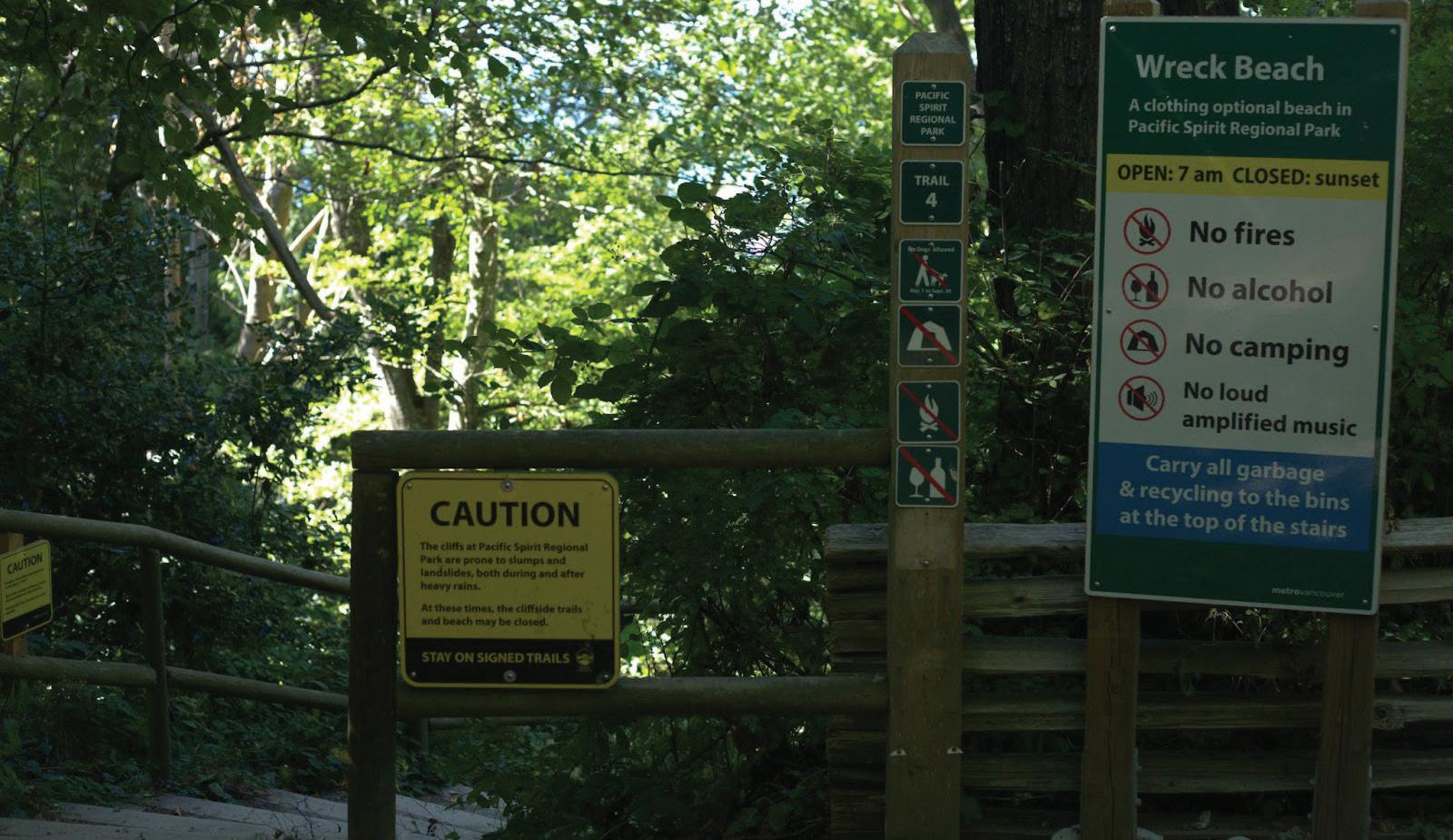
Contributor
Starting this September, UBC students will have the opportunity to take UKRN 125, a brand new six-credit course in Ukrainian language and culture.
The course will cover foundations of the language, beginning with the Cyrillic script and some basic rules of reading and pronunciation. Beyond foundational grammar rules and vocabulary, the course will explore a variety of cultural elements, such as Ukrainian music, film and folk dance.
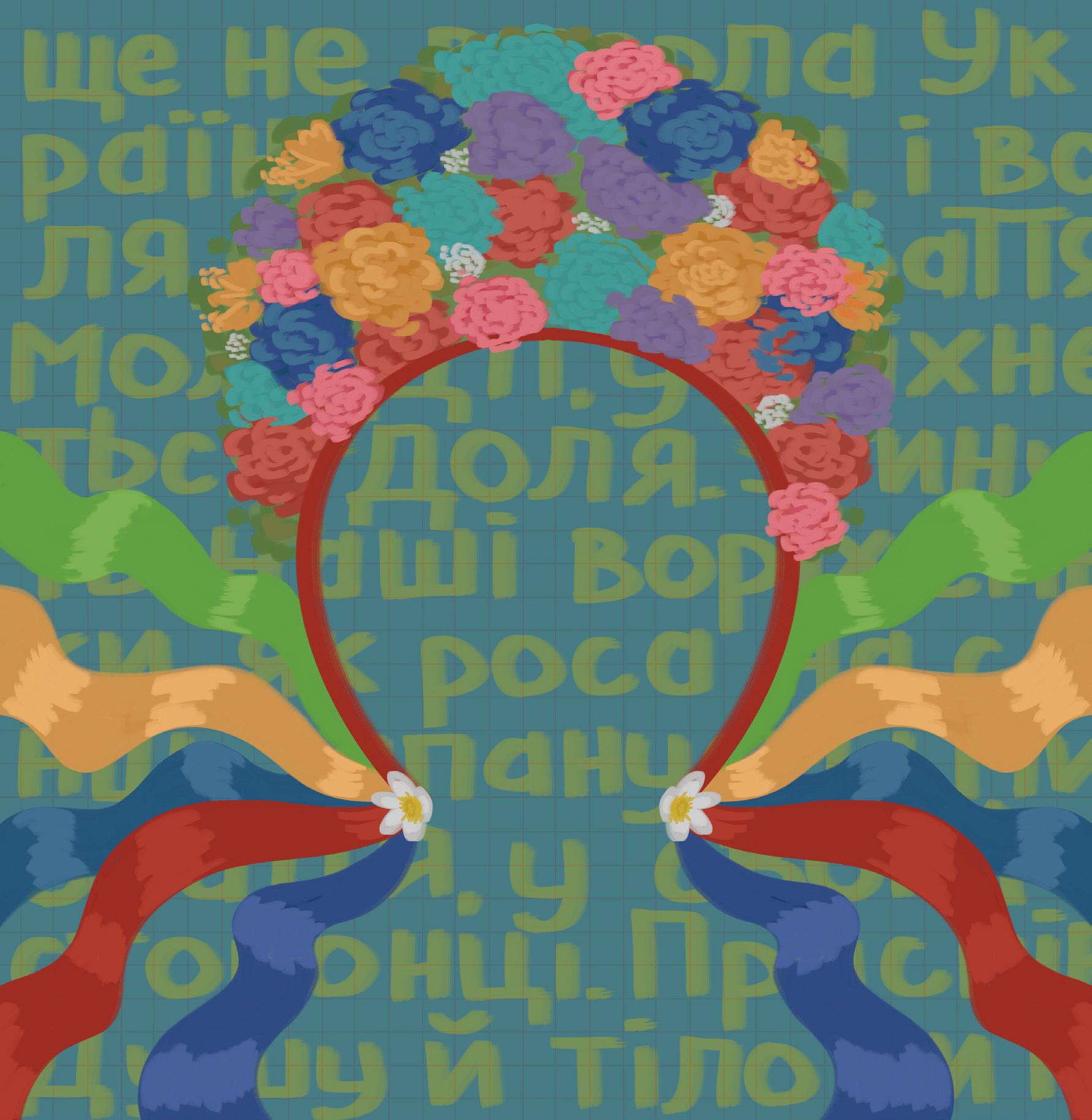
As a language-based course, UKRN 125 fulfills the new “Ways of Knowing” Arts breadth requirement under the category “Language as Meaning.” According to instructor Dr. Olena Morozova, the course will also meet the “Place and Power” breadth requirement next year, after its pilot run.
The course is designed with a diverse, “multilevel, multicultural, [and] multinational” audience in mind, from absolute beginners to heritage students. Native Ukrainian speakers, however, are encouraged to take the language proficiency test before enrolling to determine eligibility.
Morozova is confident that her teaching will offer “a new angle, perspective and approach” for everyone, even for those who may already have some grasp of the language.
In order to innovate her ap -
Morozova has a renewed perspective of its recent usage.
“Two years ago, I was terrified at the very thought that my students might be cheating, and me
said Morozova.
costing students $19.
There will instead be a multitude of small but creative assignments designed to allow every student to succeed equally while stimulating learning.
Her teaching practices are informed by what she calls “the inductive method to language teaching.” Since Ukrainian has a complex grammar system, its rules are elaborate, with many exceptions. The inductive method, therefore, encourages students to notice and pick up new concepts as they encounter them, rather than attempt to memorize every intricate detail.
Morozova’s primary goal in her teaching is to reduce learning anxiety while empowering students to become more autonomous over what they learn. This includes helping students maintain their individuality through speech by not trying to rid students of their accents.
“The accent is some kind of fingerprint,” said Morozova. “If you have no fingerprints on your fingers, where do you belong?”
In keeping with her inclusive vision, UKRN 125 will not include “midterms or end-of term exams, or any high-stakes assessments.”
Given the events happening in Ukraine right now, Morozova sees ever-greater importance to promote the Ukrainian language and keep it alive. When she launches UKRN 125 in September, she hopes the Department of Central, Eastern and Northern European Studies (CENS) will amplify her program moving forward. She also hopes UBC will continue to stand in solidarity with and lend its support to the Ukrainian people. U
Throughout August, the City Opera Vancouver’s Summer Serenades series has been offering free outdoor matinee performances on Fridays and weekends at the Sun Yat-Sen Courtyard in Chinatown, Milton Wong Plaza in Olympic Village and Roundhouse Turntable Plaza in Yaletown.

Alongside the casual settings for these performances, the repertoire — which bridges Eastern and Western music, as well as classical, popular and avant-garde styles — aims to create an accessible listening experience.
Among the performers are UBC music alumni Yenny Yeeun Lee, Alyssa Nicole Samson and Dr. Wang Yuhui, who shared their thoughts on their performances in light of their own musical journeys.
Lee’s duet performance, Donizetti and the ‘inis alongside fellow UBC music alumnus Spencer Britten, ran from August 11–13 and featured performances of songs by Italian opera composers Donizetti, Rossini and Bellini. As outdoor concerts became more prevalent after the beginning of the pandemic, Lee realized that they are great for “just grab[bing] random people’s attention” — a good approach to attracting new audiences.
This sentiment was echoed by Samson and Wang, who will perform Filipino and Chinese art songs in their joint set Manila to
Each weekend’s repertoire fits a new theme.
Beijing Direct during the last week of the concert series.
For Samson, the opportunity to leave the concert hall and head outdoors presents a “chance to bring the music out into the public in a space where it’s uncommon to find classical music.” She noted that often “people feel scared to explore [classical music] just because it has this ... characteristic of being only for the rich or only for people who
As a believer in inclusive and equitable pedagogy, Morozova always strives to ensure that her learning materials are affordable to are educated in that kind of field.”
Making the performance public and “[inviting] anyone to come and enjoy this music” can help break down those perceptions.
For all three interviewees, the visibility of the performances offers potential to achieve more than simply promoting this style of music. As racialized artists in a traditionally white-European dominated field, they are aiming to
promote cultural diversity in terms of repertoire and performers.
Samson, who is Filipino-Canadian, will perform a program consisting of Kundiman, a genre of romantic Tagalog art songs similar to German Lieder in musical form and lyrical content.
As someone who can understand but not speak Tagalog, Samson finds that “being able to sing it is really important to me, because it allows me to connect to a part of my heritage that I haven’t been able to connect to.”
She noted that she “never really gets to explore [her] heritage and [her] culture in the standard repertoire, opera series or concerts,” and only had peripheral familial exposure to Filipino music growing up.
As many Kundiman have been remade into pop songs or the opening credits for soap operas, Samson expects this to be a simultaneously novel and familiar listening experience for Filipinos in the audience, who may be hearing well-known tunes in their original art song form for the first time.
Wang expressed a similar enthusiasm at the opportunity to bring this music to new audiences. Born in Chengdu, he wrote his doctoral thesis at UBC on introducing Chinese art song pedagogy to Western universities, and has a longstanding passion for promoting the genre. He expressed disappointment that most people’s understanding of ‘Chinese music’ does not extend past folk songs or
operatic traditions. However, his past experiences introducing people to Chinese art songs made him confident in audiences’ openness to novel musical styles.
During this performance, Wang aims to provide a broad range of songs — from intimately familiar classics to avant-garde contemporary works — that will appeal to older first-generation immigrants, non-Chinese listeners and younger audiences.
For Lee, who presented pieces from the Western canon as a Korean-born mezzo-soprano, her performance doubled as an assertion that she belongs in an opera world that still excludes and discriminates against Asian performers. She noted that “it’s really hard to find an Asian mezzo-soprano in big theatres” — in Lee’s experience, she has often been seen as “too petite” to play the more assertive roles that typically sit in that vocal range.
Lee appreciates new, contemporary operas which tend to have more inclusive casting, and strongly supports creating new works “where more diverse talents can be shown.” However, she finds the exclusionary reality of casting for classical operas “really sad,” as the roles in them are the ones she grew up watching when [she] was a student.
Lee believes that presenting these kinds of performances will help “deliver more of this diversity and variety in opera” to the public. U


No matter what, visiting ubyssey.ca will take you to our award-winning reporting!
Ubyssey Editorial Board
Following the passage of the Online News Act , Google and Meta have both said they will block access to Canadian news on their platforms.
But remember, there are more ways to find The Ubyssey than Instagram posts, Facebook links or even results on Google Search.
The Online News Act forces internet platforms to negotiate revenue-sharing agreements with eligible Canadian news publishers whose content is distributed on their platforms (like hyperlinks to The Ubyssey on Google Search).
Publishers would have the choice to seek a payment scheme with Meta and Google — the only two companies likely to meet the definition of a “digital news intermediary” under the law. If an agreement could not be reached, publishers could force mediation or arbitration.
The law doesn’t force Meta and Google to carry news content, though — and they’ve started to utilize their right to not carry news in response to the law. This means news outlets, including The Ubyssey , aren’t accessible on Instagram or Facebook to some readers.
Take control of where you get your information to avoid relying on search engines and social media channels whose primary goal is not to inform you — it’s to profit from your attention.
No matter what, visiting ubyssey.ca will take you to our site.Add a bookmark to your browser or homepage to keep up with our reporting.
Really Simple Syndication (RSS) readers aggregate posts from multiple sites into one place,
like a personalized news inbox. Most web browsers allow you to add an RSS reader as an extension, but you can also download a desktop or mobile app. You can add us to your RSS feed with ubyssey.ca/rss
If you want a selection of UBC breaking news, profiles, satire and more delivered to your inbox, subscribe to our digital newslet ter Dingbat Mail by visiting our website. It drops once a week during the school year.
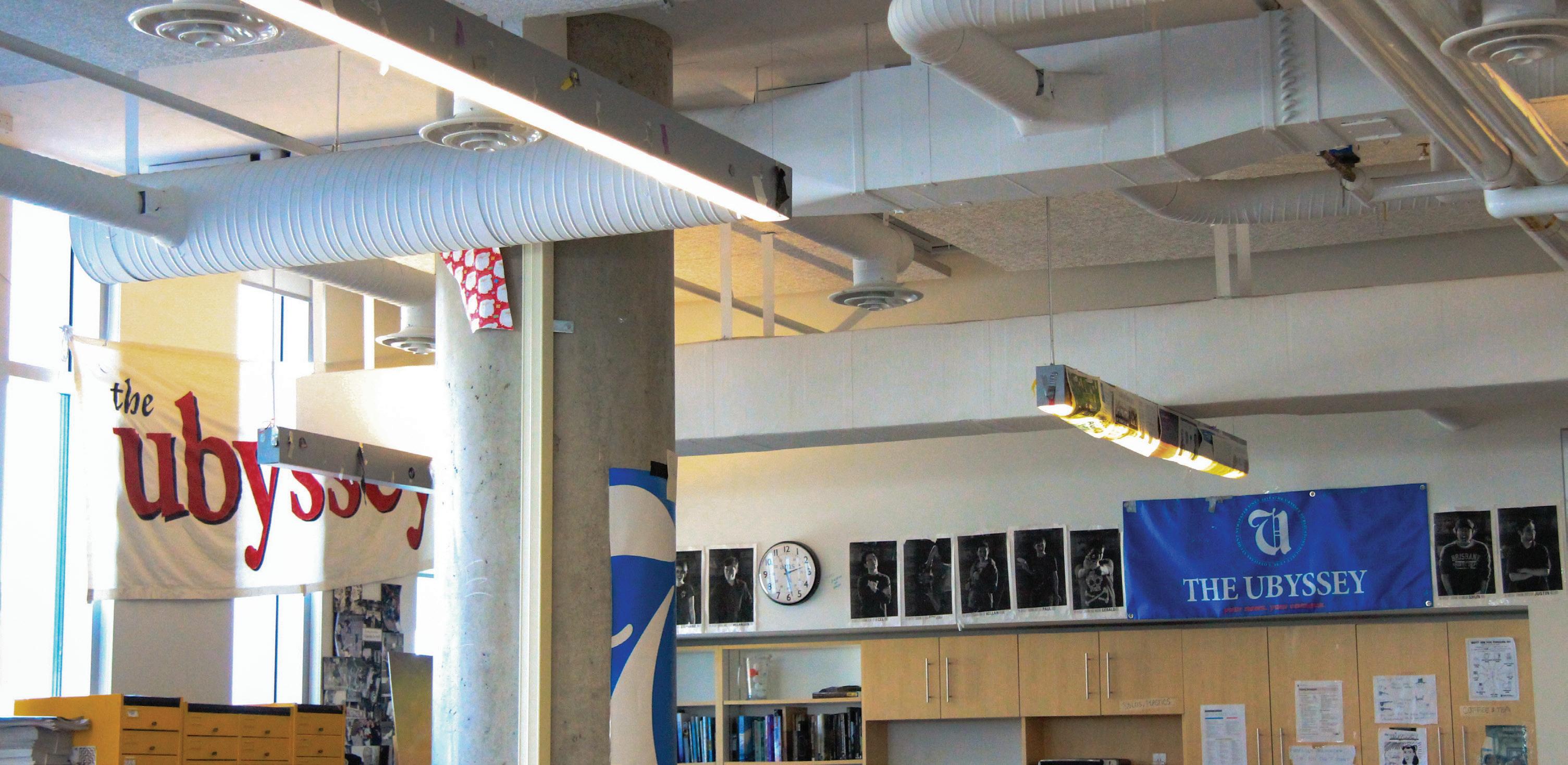
Or, if you love opening a phys ical newspaper, find a print copy of The Ubyssey on stands across campus! Read it — then use it for a collage, to wrap a gift or as an informative piece of dorm decor.
And we’re on social media too! So until we get blocked, you can find us on Facebook, Instagram, X (formerly Twitter) and LinkedIn
— all @ubyssey

Information technology companies have vast control over the information we access every day, creating situations like this one — where attempted policy interven tions into journalism can result in suddenly cutting off Canadians from vital local news sources.
So whether it’s The Ubyssey, The Vancouver Sun or The Globe and Mail, it’s more important than ever to find ways not controlled by Big Tech to access the information that’s important to you.
We’re lucky to have your support keeping us up and running regardless of the law’s outcome. Nonetheless, we’re proud of our role in keeping our community informed and hope that you allow us to do so. U
Editorials represent the opinions of the editorial board of The Ubyssey
THE EOSC BENCHES WON’T TAKE THIS SITTING DOWN //
Of all the different varieties of furniture humans have placed in outdoor spaces, none match the mighty yet humble bench. UBC certainly has no dearth of benches. Something’s gotta support my exhausted thunder thighs as I complete pilgrimages from the Forest Sciences Centre to Allard Hall.
A good bench can provide a quick main character moment — much-needed at UBC, a hotspot for imposter syndrome which can make you feel like an NPC in your own story. Here are some benches to get you started on your UBC bench-sitting journey.

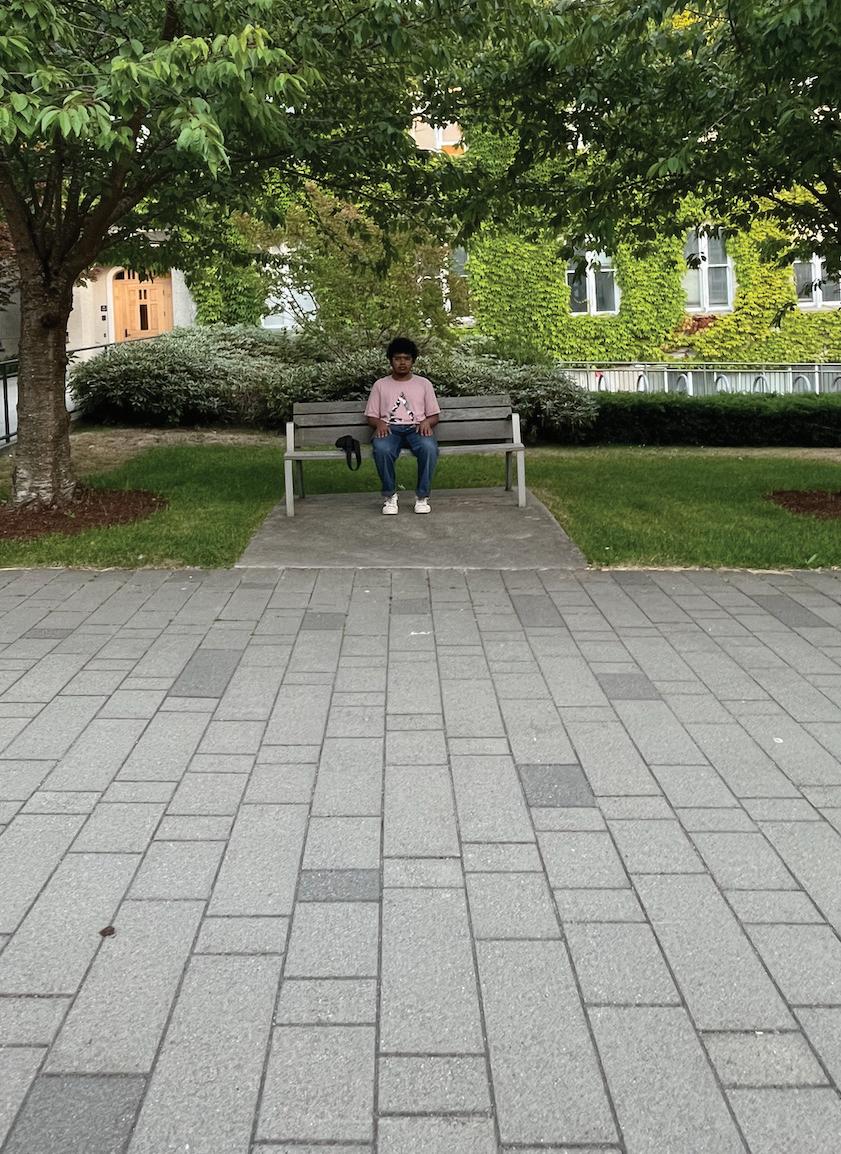

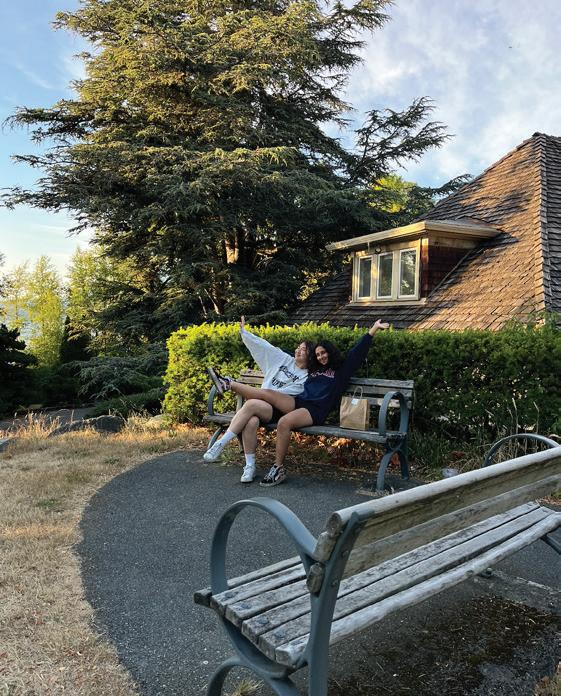
But first, let’s talk about the two things that make a bench great:
1. A beautiful location — ideally one that allows you to fall in love, cry or dissociate without anyone around to see. What would a bench be without its surroundings?

2. Back support. Let’s get to it.





a towering tree to one side, and a great sunset to the other, it’s the perfect place for a contemplative sunset with your crew (or a place to discuss the dissolution of your friend group, aided in part by the socially distanced seating).
This writer, a short king, also got a height boost thanks to the stones. You could also totally get your tall friend (we all have one) to cosplay as a sundial.

own, and is very coottage-core friendly (this is scandalous stuff! Look away! random ) if that’s your vibe. With a view of the Asian Library (this bench is so good you guys are missing out) and its water feature (me crying cause th is is such a good bench) and goo d distance betwen it and a dddddddny major roads (idk this one’s just for fun) , this bench is best enjoyed alone (or at least that’s what I keep telling myself). Trust me reader, you’re gonna wanna check this bench out (once I’m ready to stop gatekeeping it)
Located next to the Cecil Green House on the north end of campus, this pair of benches starts our list off strong. The two of them can host everything from a herd of first-years to a socially and emotionally distanced couple. With some distance from NW Marine Drive, traffic noise is minimal, making it the perfect reading space. Minus points if you’re reading a book that had its adaptation filmed there, because that book is Fifty Shades Freed.
STONEHENGE
Climb up the hill behind the Museum of Anthropology (near Stonehenge) and you’ll see this beauty tucked in the grass. With a gorgeous view of the water and perpetually #sunkissed, this bench really puts in the work. It’s also the perfect bench to have a long lost marriage-averse fling look you in the eye and tell you that they were able to commit to someone else because they felt with them what they were never sure of with you (too many 500 Days of Summer references? Please don’t axe this one, Ubyssey editor).
It feels criminal to stack in this list of cool indie benches a sellout mainstream bench. Expect no solitude here, but don’t let the crowd detract from the “I will never again be in my 20s bathed in sunlight watching the sunset over a garden of flowers” feeling these benches provide. Like its namesake album, it may feel blasé, but these benches really are some of the Greatest Benches Of All Time (GBOAT?) .
EDEN
Kyla Flynn ContributorIn an August 16 announcement, UBC unveiled their latest attempt to stay hip with the kids: “Girl Dinner” dining options will be available at all first-year residence dining halls and select UBC-run food outlets in 1 or 17 weeks.
The reveal has caused pandemonium in the university’s girlypop community.
#ZeroWaste!
UBC wrote that Girl Dinner will cost the same as their deprecated All Access Dining Plan for students and offer nearly a third of its nutritional value!
“It’s not cost-cutting — it’s Girl Dinner!”
An anonymous but hotter-thanyou member of UBC club Campus Influencers for Aritzia (CIA) said “Girl Dinner at UBC is a highheeled step in the right direction.”
Located on Memorial Road in front of the Frederic Lasserre Building is a convenient set of six benches under the cherry trees divided into two rows of three. The proximity to other bench enthusiasts gives this spot good eavesdropping potential, so sit your ass down and listen. It is sure to be a springtime favourite when a sakura-core filter descends upon these wooden gems.
[REDACTED]
A 30-second walk from “The Right Angle,” you’ll find this cute arrangement of conveniently flat-topped stones. Where there’s a will, there’s a bench, and “Stonehenge” has six. With
This gem can be found right outside the Asian Library’s (ooo don’t look here this is redacted!) main entrance. Nestled between the big cedars ( mama mia) , this bench is truly in a class of its
As a resident of Arbutus House, I have always seen and admired these benches in the middle of the St. John’s College field. Having now enjoyed them in person, I can confidently recommend these to everyone. They’re just sorta perfect in all the right ways. Plenty of sunlight filtered through leaves, warm breeze and a feeling of main character seclusion. It has a bit of an old-school charm with the all-wooden frame, and gets bonus points for an easy-to-access central location.
With that, I’m happy to say that my daily task of wasting time ranking obscure UBC artefacts is done. Which one will you sleep on when Student Housing increases rent “after consultation with students?” U
In their statement, UBC wrote “Girl Dinner is an affordable, nutritious and sexy dining option for students who prefer more whimsical dinner portions and dishes, and it’s also now the only dining option.”
The announcement follows the recent trend of substituting traditional dinner with accessible and common fridge and pantry items (colloquially known as snacks). By hopping on this trend, UBC proves they are just like other girls and won’t address food insecurity. Slay!
In concept art leaked by disreputable source ‘ugly’ Geoff, Girl Dinner appears to include an assortment of cheese cubes, small vegetables such as baby carrots, individual edamame beans, gummy bears but just the red ones, USB-C cables and construction detritus.
Santana Ohno, a sixth-year self-proclaimed baby carrot gobbler said “it’s giving” and educated The Ubyssey on the twenty-eight different types of carrot used in the complex process of baby carrot manufacturing. That’s four hours of my life I’ll never get back!

I tried to contact anyone who knows anything about the ongoing food insecurity crisis, but I forgot the password to my email and then my dog ate my laptop charger and then my WiFi stopped working. We here at UBC’s longest running girl newspaper are excited to try this new dining option from the comfort of our hot girl piles. As far as we’re concerned, Girl Dinner isn’t just for the girls – Girl Dinner is for everyone*. U
*There are no other options.
I’VE BEEN KNOWN TO BE FASCINATED BY A PIECE OF CHEESE // UBCJOCELYN BAKER / THE UBYSSEY
STILL BETTER THAN GETTING MARRIED TO CANON IN D //
My first memory of the Nest is one of comfort. I had just finished my first lecture and knew nothing about campus. As I stepped out of Buchanan Block B, I couldn’t even open Google Maps before being swept away by a stream of students headed towards the Nest.
After being shoved through the doors, I was in awe.
The screeching of 11-year-olds failing to land kick flips, the smell of burnt coffee from Blue Chip and the gorgeous white walls (which block the construction) moved something within me, and in that moment, I knew:
This is where I’ll have my wedding.
You might be wondering who’s the lucky person — if I’ve already found the location, we must be pretty serious.
There’s no one. I am single. That’s unimportant to the vision, though.
GAMEPLAN
I have every detail planned out.
Guests will sit on the sides of the staircase steps, and I will make my entrance down the middle. It will be a black tie affair, of course. We’ll blend right in with all the students milling around in their Blundstones and UBC crewnecks.
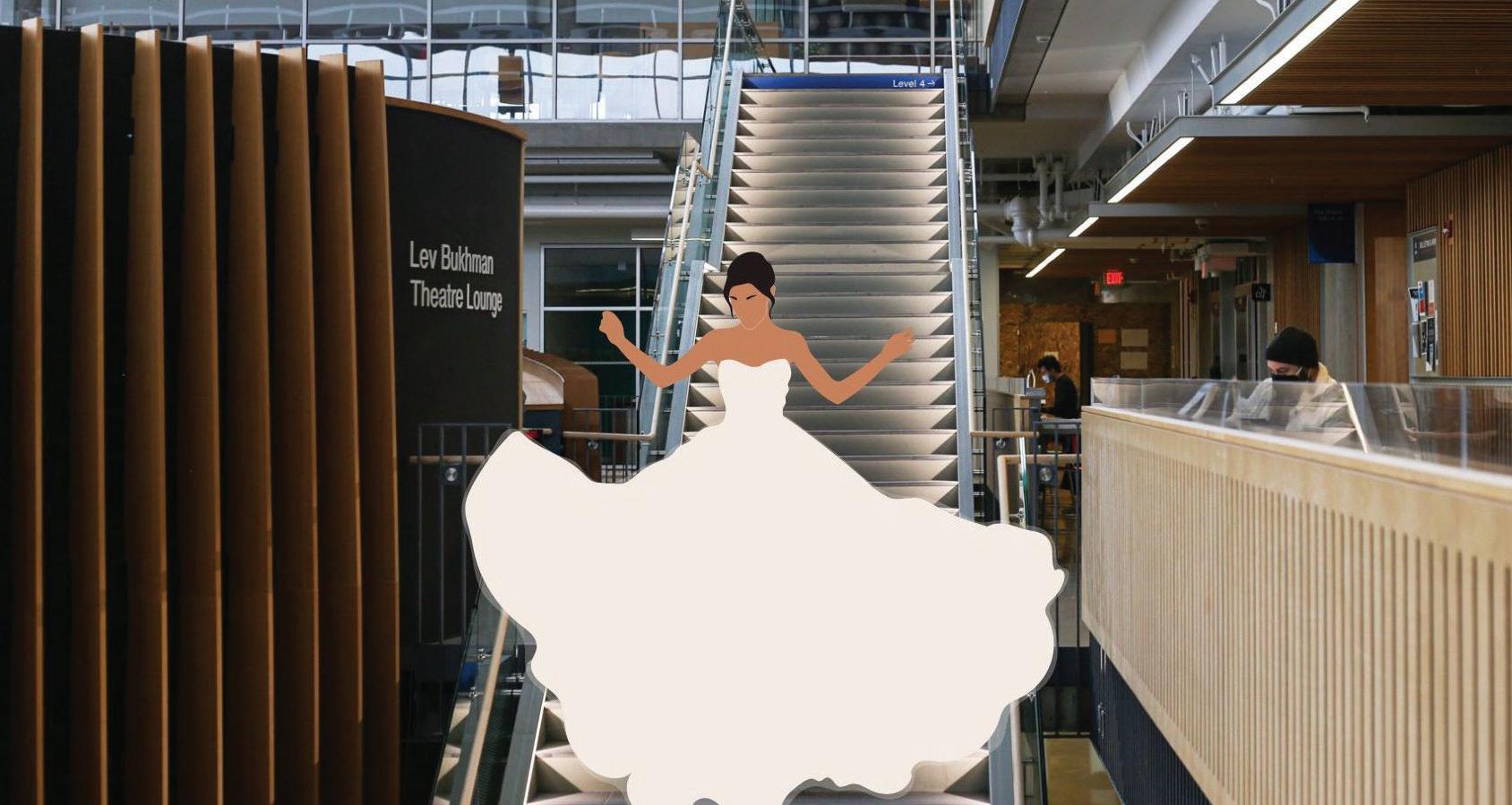
Who will officiate the ceremony? I tried to get Santa, but he’s too Michigan-core for us (me). I haven’t reached out to Bacon yet, but he will definitely be officiat-
WHOOPS //
ing.
I would hire the UBC Jazz Club to play some smooth tunes as I descend from the Egg, but that’s an unnecessary fee. Instead, I’ll just do the wedding on a Thursday, so I can walk down the aisle (steps) accompanied by the sweet sound of a first-year cry-belting “WE ARE NEVER EVER GETTING BACK TOGETHER” at The Gal’s karaoke
night. The doors will be open and mic on full blast.
Afterwards is the food. Lucky for me, the Nest has a plethora of options. I’m thinking tomato soup from Soup Market, followed by the spicy chicken on rice (so dry) from the Flavour Lab and finish the night off with some Blue Chip Marbelous cookies (no cake).
The reception will be in the Nest too! Where? The Pit, of
course. No windows, dim lighting and 419 people (gotta invite the cousins!) squished into a room the size of a postage stamp to dance the night away, aided by a student DJ who does not know how to read a room.
Fucking perfect.
The theme would obviously be existential dread (what if I have to get divorced and everyone

here knows I just spent my life savings on one day, which I now regret because I made the wrong decision choosing the love of my life?!). It’ll be so cute!
The Nest has everything I need and want at my wedding. It makes sense since the AMS is a student-led, student-focused and student-first group that needs my booking fee because they are so very broke. U
But if you really think about it, are they?
Kids these days have things so good, being able to access the spaces they’ve paid to access, paying thousands in tuition, suffering through the hundredth year of late-stage capitalism.
Back when I was a student, things were imperceptibly worse. Sure, we had elevators, but they were slower. There was also someone to help you if they weren’t working. Anyways, we’ll be with you within the hour or the week.
What services? There aren’t any services for you to access. Why are you trying to access services? Are you a cop? You have to tell me if you’re a cop. It’s the law. I think.
Sorry, looks like our automated service delivery AI isn’t ready yet. Our AI (three minimum wage workers equipped with ChatGPT) replaced overnight residence commonsblock staff on August 1. We’re still working out the kinks,
but in the meantime, here’s how to access commonsblock services after 11 p.m.
OUR AI IS ALWAYS LISTENING (IF YOU CAN CALL US)
Always have your phone on you and charged to 100 per cent. This shouldn’t be a problem as phone batteries peak at midnight.
After a day of using your phone to navigate around campus, stay in touch with your friends, take a photo of Jeremy
(the sandwich), get directions to Browns (the cool one off campus), pay for your drinks (eight Chain Famous’) and get directions to Browns (on campus but they also serve Chain Famous’ so it’s ok), it should have at least 70 per cent charge remaining. You definitely won’t be asking Jeremy (the person you met at Browns) to borrow their phone because yours died hours ago and the 99 still hasn’t shown up.
If your phone is somehow out of charge (dead, some might say),
just ask another student (Jeremy works) for theirs — after all, the people whose job it was to help you don’t work here anymore! Whoops!
WAIT YOU NEED ACTUAL HELP?
Now you’ve got a working phone and are contacting our AI because the elevator isn’t working. We can understand how this could seem like a problem — elevators are a necessary accessibility feature.
You’ve made it to your dorm, but your door code isn’t working. Perfect! We left to assist another student across campus in the two minutes since helping you, but we’ll be back so fast you won’t have time to say “Thanks for increasing my rent!”
While you wait, feel free to head to the commonsblock. No one will be there to help you, but it’s a great place to sleep until front desk staff arrive at 7 a.m. Show your UBC pride by using your school hoodie as a blanket! Cozy!
We’re so glad we could help. Now get off our backs lol! Our daily motivational desk calendar says we’re doing a fucking sick as hell job, so stop complaining . U
Is it possible to masturbate too much? Can pregnant people experience sexual desire? Does good sex always involve orgasms?
Psychology graduate student Kiarah O’Kane has the answers.
Throughout their undergrad, they contributed to a slew of different laboratories but quickly realized that sex research was their path.
After taking an undergrad course on the psychology of human sexuality, O’Kane jumped at the opportunity to work in Dr. Samantha Dawson’s new Sexuality and Well-Being (SWell) Lab.
O’Kane has watched the SWell lab’s team grow, and its scope of research topics expand. Ongoing studies are looking into the transition into parenthood, sexual pleasure and memories of first sexual experiences.
O’Kane’s current focus is the Sexual Opinions, Attitudes, and Knowledge Study (SOAK), which focuses on identifying prevalent sexual myths, and debunking them through public communication campaigns.
SOAK participants were exposed to a prevalent myth about sex, then asked to rate their agreement with it.
Preliminary findings show that people assigned male at birth, cisgender and heterosexual people are more likely to believe myths about sex, while people assigned female at birth and 2SLGBTQIA+ individuals are less likely to do so.
These results came as a surprise to researchers, because “sex education within schools usually focuses on majoritized groups, and is mostly relevant to them,” according to O’Kane. Since sex ed disproportionately focuses on the experiences of cis straight men, shouldn’t they come out with the most accurate understandings?
“I think the findings suggest that our sex ed as it is just isn’t good enough and comprehensive enough to benefit even the people that it’s focused on,” O’Kane said.
CLOUDY WITH A CHANCE OF TARGETED ADVERTISING //
Not only do sex ed curricula primarily reflect cishet experiences, but the world of sex research does too.
Though O’Kane has found a community of Queer sex researchers to support them, this diversity is not reflected in all sex research — something that they hope to change with this study.
“I think my own experiences, and seeing the experiences of my community members, really made me understand that, at least when it comes to sex education, there’s a deficit in terms of the information that Queer people receive in schools or have access to about sexuality.”
They are hopeful that their
emphasis on using diverse samples in SOAK will provide more insight to future sex researchers on the sexual health and wellbeing needs of Queer people.
Using the Instagram account @misconsexions, they hope not only to identify where sexual myths take root, but to find the best ways to creatively communicate the facts.


Each post on @misconsexions presents a specific myth about sexuality, and the following slides debunk it by sharing “evidence-based information from recent research, especially research that focuses on LGBTQ+ people and diverse samples.” All posts
are presented in an easy-to-follow format, “using more accessible language than if the general public was reading a research paper by themselves,” said O’Kane.
“Sex research in general is pretty new as a field, which is really exciting, because it means a lot of the questions that you want to ask haven’t necessarily been done before,” said O’Kane. “Knowledge translation within sex research is something that’s gaining a lot of traction and a lot of attention.”
Most of the research that O’Kane has come across focused on specific sexual dysfunctions rather than improving general sexual knowledge, making SOAK one of the first studies of its kind.

O’Kane also noted that much research falls victim to the “valley of death” — the phase between doing research and actually implementing these findings into potential solutions. She hopes that knowledge translation initiatives like @misconsexions can “bridge that gap a little bit and disseminate research findings a lot faster.”
In the future, the SOAK team hopes that their work can positively influence sex ed curricula and lay the groundwork for other “brief knowledge translation interventions [that] can be effective for improving people’s sexual knowledge.” U
Weatherhood for weather service. When you visit their site, Weatherhood gives the most accurate weather for your exact location.
Weatherhood hopes to use this information to deliver “weather-triggered advertising,” according to Edmonds. This means that users see ads that better match the conditions that Weatherhood’s data projects— for example, an ad for a coffee shop would be tailored to either show hot options in the cold and iced drinks in the heat.
“When it’s sunny, we’re going to deliver sunny creative, when it’s rainy we’ll deliver rainy creative,” Edmonds said. Weather based advertising has been previously shown to be effective for boosting advertisement views as well as product sales.
as Dunbar or Point Grey, tend to have more tree coverage than less affluent areas like Strathcona or the Downtown Eastside, as a 2019 UBC study found.
Differences in temperature across the city can become dangerous in hot summer months, when some neighbourhoods can be as much as 17 degrees hotter than others.
Weatherhood has the potential to alert citizens of dangerous heat and direct people towards cooler temperatures. Edmonds said their partner organization in Switzerland is already doing so.
“They let citizens know, ‘Hey, it’s 10 degrees hotter in this area, head over to the park in this area where it’s 10 degrees cooler to help yourself.’”
Bea Lehmann Senior Staff WriterVancouver’s first hyperlocal weather network, Weatherhood, launched on July 19.
The project is a collaboration between Glacier Media and UBC’s Department of Earth, Ocean and Atmospheric Sciences.
If you’re wondering what hyper-local weather forecasting means, think about a time when a weather app has told you it’s partly sunny with clouds, even as you’re getting soaked by a downpour.
Turns out, most local weather forecasting may be less local than you think. In Vancouver, the nearest weather station run by Environment Canada is in Richmond.
Meteorologists use data from existing stations to extrapolate what is happening in between them, but the variation that exists in these in-between areas can result in less than accurate weather.
“The challenge there is that when you have the types of diverse topography - the actual height of the land, and where the ocean is - having those stations so far apart and using traditional grid modeling [leads to] a lot of inaccurate weather forecasts,” said Kemp Edmonds, the director of Weatherhood. “There are massive differences in temperature and wind and other conditions across small areas.”
Nearly sixty sensors have been installed by Weatherhood across Metro Vancouver, between one
and ten kilometres apart. The data from these weather stations are fed into a service called Meteo Blue that uses multimodal data modeling to create forecasts for each sensor’s location.
Kat Pexa is a research assistant with UBC’s Weather Forecast Research Team who was involved in the installation of Weatherhood’s stations across the city.
“They’re standalone and wireless,” Pexa said. “They don’t connect to the building, and communicate using a SIM card.”
“For the smaller stations, we have temperature, relative humidity and precipitation,” Pexa said, “For our bigger stations … [we also have] solar radiation and wind.”
Local news website Vancouver Is Awesome is already using
PREDICTING MICROCLIMATES IN A CHANGING CLIMATE
Weatherhood also hopes to work with municipalities to provide climate-related services.
One area of concern for cities is the urban heat island (UHI) effect, which refers to the phenomenon of cities being warmer than surrounding areas.
UHI stems from factors such as human heat-generating activities like driving cars and air conditioning, dark roofs that absorb rather than reflect sunlight, lack of tree canopy and green space, and well as impermeable surfaces such as paved roads and concrete buildings.
UHI effects are not spread evenly across cities. In Vancouver, wealthier neighbourhoods, such
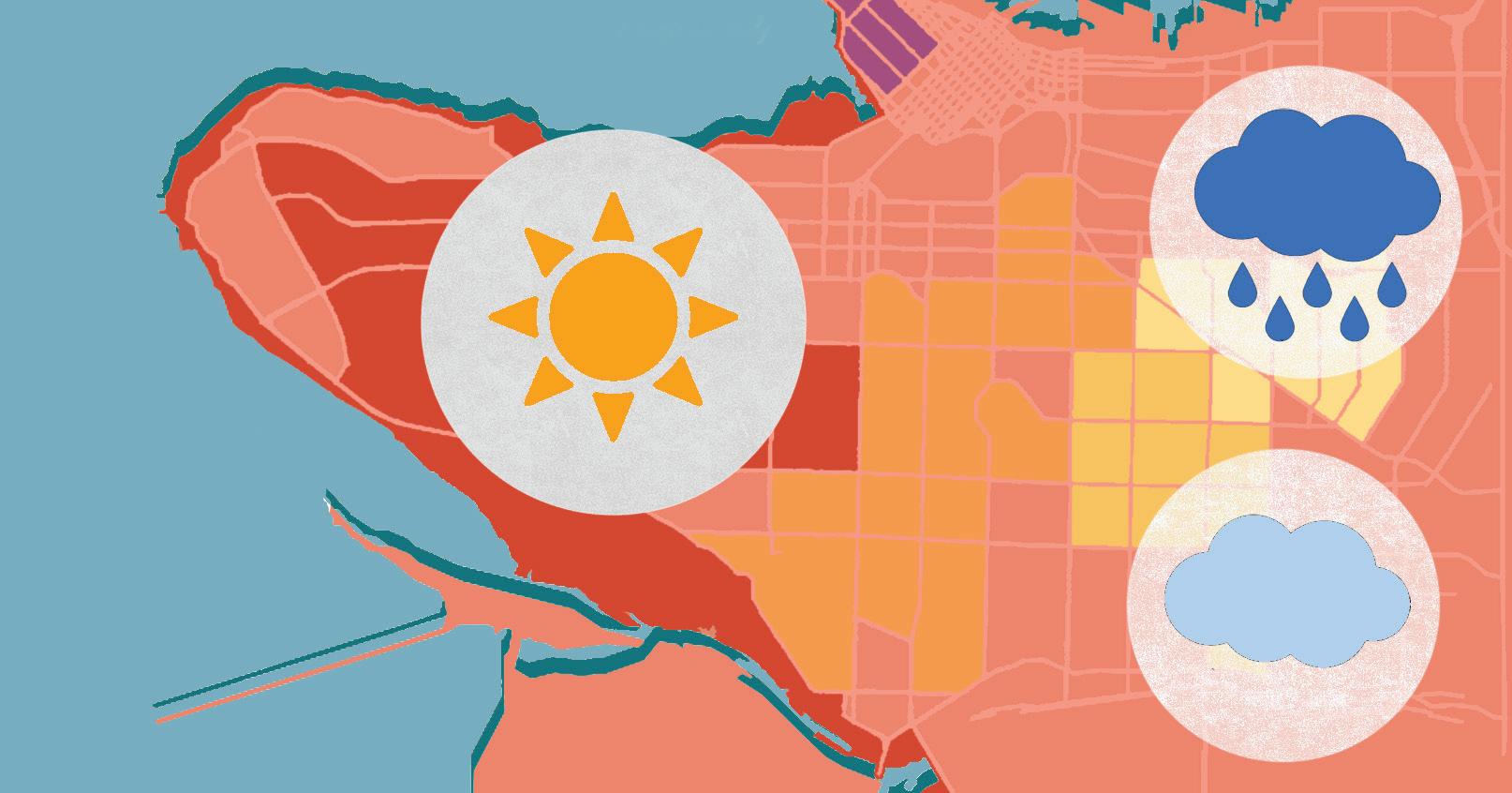
In the bigger picture, Edmonds said that urban planners could use Weatherhood to avoid putting people at heat risk.
“When you’re about to put in a brand new social housing development, where do you want to put it? Well, we don’t want to put it where … temperatures are super high.”
Edmonds is optimistic about the possibility of different applications for Weaterhood going forward.
“For us, we’re a business,” he said, “What it really comes down to is what are people willing to pay for and support financially.”
“I think the timing for the smart city climate networks is really good because the will is there, and the budgets will follow ... the technology is in a great spot in terms of what it costs and what it can do.” U
As Vancouver cruises into its summer crescendo, the warm breeze that makes the perfect beach day can ratchet the city into a public health emergency.
Last week, 17 daily heat records were broken in BC, and the 10 hottest places in Canada were all in the province.
This summer has not yet brought Vancouver the extreme temperatures of the deadly heat dome in 2021. Still, temperatures in May and August have spiked higher than average — a trend correlated with the climate crisis. Heat waves are also sweeping Europe and the Southern US.
What does heat do to our bodies and communities, and how can Vancouver adapt?

Dr. Sarah Henderson, an assistant professor at UBC and senior scientist in environmental health services with the BC Centre for Disease Control, specializes in the public health impacts of extreme heat events.
According to Henderson, heat starts causing problems when it causes the body to stray from its healthy internal temperature. For humans, the range of internal temperatures we can tolerate is fairly rigid.
“Your body wants to maintain a body temperature of 36.6 °C, and there’s not a lot of leeway there,” said Henderson. “So if you start reaching an internal body temperature of 39 or 40, you will get heatstroke.”
The body has a variety of ways to cool off, from facial flushing to sweat.
“The body will apply different measures to try to stay cool, and usually that happens quite effectively,” said Dr. Michael Schwandt, a professor at the UBC School of
Population and Public Health. “[But] if we become [too] dehydrated, from sweating and loss of fluids in the heat, we can actually have a shock to the circulatory system.” This means the brain, kidneys and other organs don’t get the blood they need to function.
This is, of course, assuming a perfectly healthy body in an unpolluted environment. In reality, we live in a world with increasing risk of exposure to air contaminants, such as wildfire smoke.
general,” said Schwandt.
Socio-economic conditions are also very influential in determining risk from extreme heat.
According to Henderson, many heatstroke victims get it indoors. Low-income housing often lacks cooling infrastructure. The BC Coroner’s review of the 2021 heat dome found that 10 per cent of the 619 deceased lived in social housing, Single Room Occupancy (SRO) and supportive housing, and that high-indoor temperatures were the leading cause of death.
es, keeping in heat and letting little out.
“I think that at the individual level, one of the things that many of us can do is to be aware of those around us in our communities who might be at higher risk and to support them,” said Schwandt. He emphasized looking out for those living in isolation, the elderly and those with disabilities.
Henderson gave a few tips on
managing our personal spaces. She recommended closing the windows and blinds during the hottest of hours, and reopening them once the weather is cooler to help bring in colder air (preferably with the aid of a fan).
“If you’re being careful about keeping sun off the windows and managing the indoor temperatures as best as possible, you can make a two to four degree difference indoors and that can be the difference between life and death for people.” U
Vancouver’s air quality declined on Saturday due to the hundreds of fires burning across the province. The fine particulate matter in wildfire smoke (called PM2.5, because the particles are under 2.5 micrometres in diameter) are small enough to enter the bloodstream, which can stress the cardiovascular system, impairing breathing and brain function.
“Many of the people living in those conditions aren’t going to be able to afford air conditioning [units] or the energy costs associated with air conditioning.”

The smoke rolled in on the tail end of last week’s heat wave.
“The combined exposure of heat and smoke is worse than the sum of its parts,” said Henderson.
According to Henderson, the immune system responds to particulate pollutants like smoke by causing inflammation, which stresses an already-heat stressed body further. The combination of inflammation and heat stress produces a “multiplicative effect.”
Demographic factors also play a big role. During the 2021 heat dome in the Pacific Northwest, over 90 per cent of all heat-related deaths were individuals over the age of 60, with no deaths reported in those under 30.
“Our mechanisms for cooling off just become less effective with age in
Studies have repeatedly shown that areas with lower-income residents and renters often have less shade and green spaces compared to more affluent neighbourhoods.
“Less vegetation, more paved areas, and so forth, contribute to urban heat islands where we can have temperatures that are actually substantially hotter,” said Schwandt.
Vancouver, per a UBC study, showed the strongest correlation between average neighbourhood income and availability of green space compared to other metro areas in the country. The study suggests that Vancouver’s heat crises are a more extreme issue of social injustice in urban planning and public health than in other Canadian cities.
Vancouver is also especially not built for heat.
“We’ve really focused on building houses that are energy efficient for retaining the heat,” said Schwandt. This is great for staying warm in the rainy months, but in the summer, older Vancouver residences act like greenhous -
As a UBC varsity volleyball player, Tim Frick helped his team to the 1975/76 national championship.
Unbeknownst to him, his remarkable success on the court would continue in a different capacity.
Frick achieved unprecedented success as head coach of the Canadian women’s wheelchair basketball team from 1990–2009. He led the team to win three consecutive gold medals at the 1992, 1996 and 2000 Paralympic Games and four consecutive World Championship titles from 1994–2006.
“The overall approach that we took during those years of success was this rule of having unconditional acceptance for each other [and] making sure that everyone’s role on the team was clearly defined,” said Frick.
This included accepting and understanding how people learn in different ways, how people respond differently to things and “awareness of people’s tendencies [and] the acceptance of that, [which] leads to tremendous tolerance.”
His approach to coaching is something Frick attributes to his time at UBC. He played on the varsity volleyball team for five years, graduating from UBC with a bachelor’s of physical education (now equivalent to a kinesiology degree) in 1975 and a master’s of education in 1980.

Through the guidance of coaches, professors, colleagues, classmates and teammates at UBC, he not only fell in love with coaching, but “realized that coaching was less about the ‘X’s and O’s’ [and] was more about the interpersonal relationships, humanity and treating people really, really well.”
Reflecting on his career, Frick said compassion was especially important to his coaching.
“It [is] great to be a content expert, but showing compassion and care and true interest in the welfare of someone’s livelihood is really what counted and made a difference.”
It was also at UBC where Frick was introduced to adaptive sports. During his master’s degree, he connected with a fellow athlete named Rick Hansen — a Canadian Paralympic track and field athlete and activist — who asked him to coach wheelchair
sports.
Since Frick knew volleyball well, he started coaching wheelchair volleyball — later expanding to wheelchair track and athletics and wheelchair basketball. Through Hansen and wheelchair basketball, Frick met Terry Fox and ended up coaching him too.
“It created a really cool bond between the three of us,” said Frick.
“Those days were the cusp of innovation for sports technology in both wheelchair sports and the prosthetic world. There was no training literature out there. So we had to brainstorm and make it up as we went along. The creativity, innovation and technology part was a lot of fun — plus we just became really good friends and hung out all the time.”
Coaching at UBC would lead to a career that would span nearly 50 years of coaching athletes with and without disabilities. After graduation, Frick coached volleyball at Langara College and even attended the 1984 Paralympic Games with Hansen. He started working in sport development with Wheelchair Basketball BC, and in 1990, Frick was asked to coach the national women’s wheelchair basketball team.
“And I said, ‘I’ll do it for a year, I promise you that at World Championships next year, the team will have a peak performance ... and then after that, you guys can figure it out from there,’” he recalled. After a bronze medal at the World Championships in 1990, Frick came back to coach for the next season to “see how it goes.” He ended up coaching the team for 19 years.
Frick sees no difference in the way he coaches when it comes to disabled and non-disabled athletes.
“If you break it down to its most basic level, coaching any sport and any athlete has to be individualized. So from that point of view, [there’s] obviously no difference at all,” he said.
In recognition of the significant contributions and achievements he’s made in coaching, Frick has received numerous awards and honours — including winning the BC Wheelchair Sports Coach of the Millennium award, being appointed to the Order of Canada in 2020 and being the first Paralympic coach inducted into the Canadian Hall of Fame.
“The moments [that are] the pinnacles of success [like] when you realize you’re about to win a gold medal are obviously super
highlights [but] there’s lots of highlights that occur in just practices,” said Frick, “[Like] a player making their first basket [or] when you see the light bulb go on [in a player] who figures out something that you were trying to wrack your brain to find ways to explain [and] when you leave the gym sometimes and the kid will just say, ‘Thanks coach’ — those moments are fantastic.”
Frick has retired, but continues to share the sport of wheelchair basketball to more people — including to the future generation.
On Pender Island in BC, Frick established Pender Island School Basketball that has been running for the past 14 years. Children with and without disabilities ages 10–17 can come together to play wheelchair basketball and have opportunities to meet Paralympic athletes who talk about awareness, inclusion, adaptations and disability. From these sessions, the children form friendships with each other.
“Then, a disability becomes something that nobody really notices. They go on adventures together and do stuff together. It’s a great way to develop awareness and a view of the world in terms of accessibility that I think is important for people to know.” U
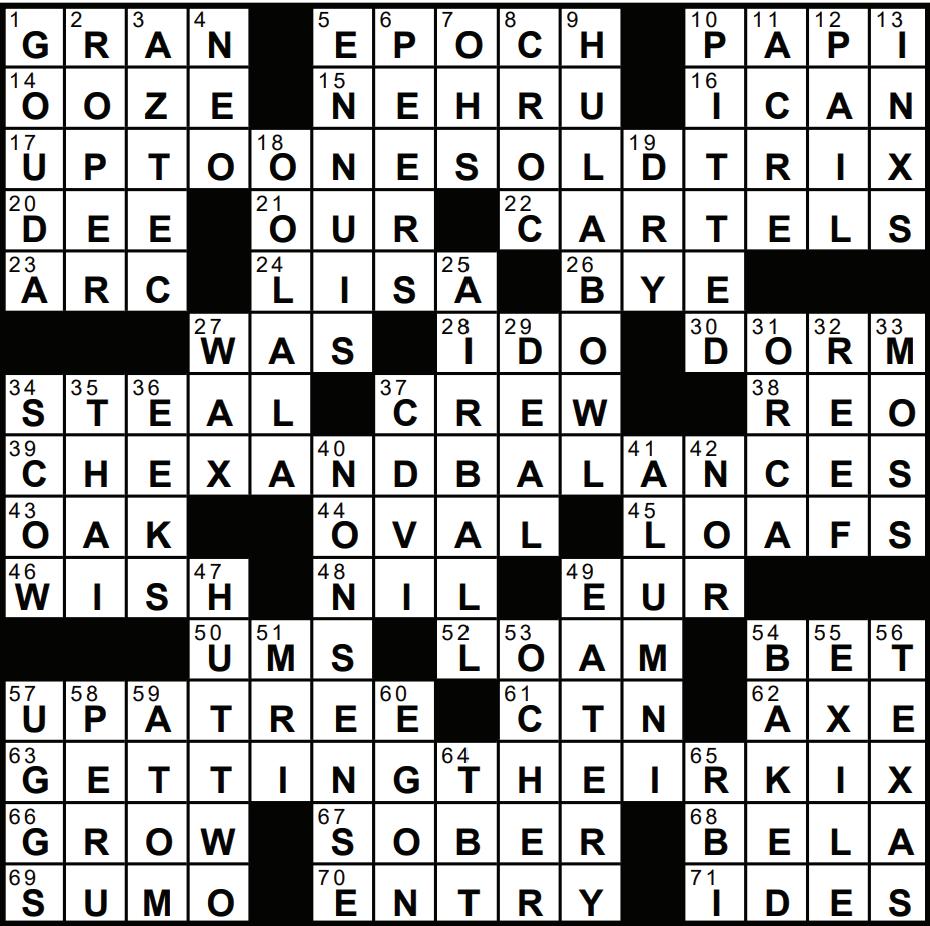



1. Bit of tea residue
5. College or collar
9. Encourage
14. “But it was ___ dream!”
15. Sulk
16. Harvests
17. Level
18. Concept
19. Skylit spaces
20. Comedian paired with crooner in a series of “Road” movies
23. Colorless, odorless gas
24. “Isn’t it rich? Are ___ pair?”
25. Husband and wife paired on a string of hits and a TV
1. Wood shaper
2. “The Waste Land” author
3. Hebrew’s first letter

4. Area that includes Japan and Vietnam
5. Celebrated
6. Ms. Lincoln’s maiden name
7. Petrol-exporters’ org.
8. Close to
9. Cleared the chalkboard
10. Beatles song about Jojo
11. Indiana steel city
12. Popular nail polish brand
13. DOD intelligence agency
21. “Ummm...that would be ___”
22. Possesses
show 32. Verve
35. Labors
36. Hindu goddess of time
37. O’Hare flt. info
38. Blanket not to bring to a slumber party?
39. “The way I see it,” in texttalk
40. Incursion
42. “One Flew Over the Cuckoo’s Nest” director
Forman
44. Many
45. Portly man and thin man paired in comedies 48. Gal’s partner
26. Hopeless type of situation
27. Downward-pointing triangle road sign
49. Corot or Cassatt
53. Hawaiian girl and an ET paired in a Disney movie
57. Supreme Samuel
59. Word repeated in